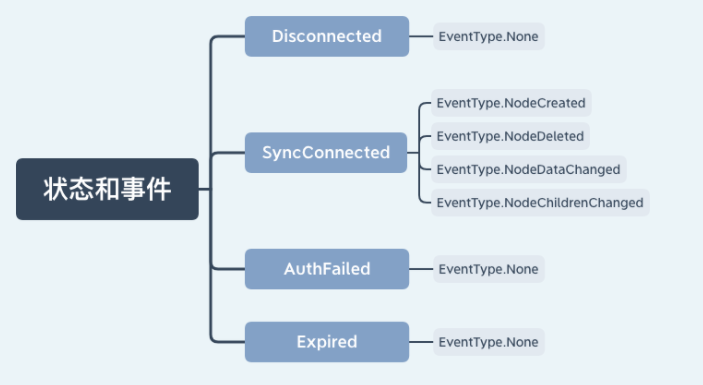Zookeeper的watch机制
概况:大体上讲 ZooKeeper 实现的方式是通过客服端和服务端分别创建有观察者的信息列表。客户端调用 getData、exist 等接口时,首先将对应的 Watch 事件放到本地的 ZKWatchManager 中进行管理。服务端在接收到客户端的请求后根据请求类型判断是否含有 Watch 事件,并将对应事件放到 WatchManager 中进行管理。
在事件触发的时候服务端通过节点的路径信息查询相应的 Watch 事件通知给客户端,客户端在接收到通知后,首先查询本地的 ZKWatchManager 获得对应的 Watch 信息处理回调操作。这种设计不但实现了一个分布式环境下的观察者模式,而且通过将客户端和服务端各自处理 Watch 事件所需要的额外信息分别保存在两端,减少彼此通信的内容。大大提升了服务的处理性能。
具体如下:
客户端 Watch 注册实现过程
我们先看一下客户端的实现过程,在发送一个 Watch 监控事件的会话请求时,ZooKeeper 客户端主要做了两个工作:
- 标记该会话是一个带有 Watch 事件的请求
- 将 Watch 事件存储到 ZKWatchManager
我们以 getData 接口为例。当发送一个带有 Watch 事件的请求时,客户端首先会把该会话标记为带有 Watch 监控的事件请求,之后通过 DataWatchRegistration 类来保存 watcher 事件和节点的对应关系:
public byte[] getData(final String path, Watcher watcher, Stat stat){
...
WatchRegistration wcb = null;
if (watcher != null) {
wcb = new DataWatchRegistration(watcher, clientPath);
}
RequestHeader h = new RequestHeader();
request.setWatch(watcher != null);
...
GetDataResponse response = new GetDataResponse();
ReplyHeader r = cnxn.submitRequest(h, request, response, wcb);
}
之后客户端向服务器发送请求时,是将请求封装成一个 Packet 对象,并添加到一个等待发送队列outgoingQueue 中:
public Packet queuePacket(RequestHeader h, ReplyHeader r,...) {
Packet packet = null;
...
packet = new Packet(h, r, request, response, watchRegistration);
...
outgoingQueue.add(packet);
...
return packet;
}
最后,ZooKeeper 客户端就会向服务器端发送这个请求,完成请求发送后。调用负责处理服务器响应SendThread 线程类中的 readResponse 方法接收服务端的回调,并在最后执行 finishPacket()方法将 Watch 注册到 ZKWatchManager 中:
private void finishPacket(Packet p) {
int err = p.replyHeader.getErr();
if (p.watchRegistration != null) {
p.watchRegistration.register(err);
}
...
}
服务端 Watch 注册实现过程
介绍完客户端对 Watch 请求的发送过程,下面我们来看一下服务端是如何处理一个 Watch 事件。
Zookeeper 服务端处理 Watch 事件基本有 2 个过程:
- 解析收到的请求是否带有 Watch 注册事件
- 将对应的 Watch 事件存储到 WatchManager
下面我们分别对这 2 个步骤进行分析:
当 ZooKeeper 服务器接收到一个客户端请求后,首先会对请求进行解析,判断该请求是否包含 Watch 事件。这在 ZooKeeper 底层是通过 FinalRequestProcessor 类中的 processRequest 函数实现的。当 getDataRequest.getWatch() 值为 True 时,表明该请求需要进行 Watch 监控注册。并通过 zks.getZKDatabase().getData 函数将 Watch 事件注册到服务端的 WatchManager 中。
public void processRequest(Request request) {
...
byte b[] = zks.getZKDatabase().getData(getDataRequest.getPath(), stat,
getDataRequest.getWatch() ? cnxn : null);
rsp = new GetDataResponse(b, stat);
..
}
服务端 Watch 事件的触发过程
在客户端和服务端都对 watch 注册完成后,我们接下来看一下在 ZooKeeper 中触发一个 Watch 事件的底层实现过程:
上图中列出了客户端在不同会话状态下,相应的在服务器节点所能支持的事件类型。例如在客户端连接服务端的时候,可以对数据节点的创建、删除、数据变更、子节点的更新等操作进行监控。

我们以 setData 接口即“节点数据内容发生变更”事件为例。在 setData 方法内部执行完对节点数据的变更后,会调用 WatchManager.triggerWatch 方法触发数据变更事件。
public Stat setData(String path, byte data[], ...){
Stat s = new Stat();
DataNode n = nodes.get(path);
...
dataWatches.triggerWatch(path, EventType.NodeDataChanged);
return s;
}
下面我们进入 triggerWatch 函数内部来看看他究竟做了哪些工作。首先,封装了一个具有会话状态、事件类型、数据节点 3 种属性的 WatchedEvent 对象。之后查询该节点注册的 Watch 事件,如果为空说明该节点没有注册过 Watch 事件。如果存在 Watch 事件则添加到定义的 Wathcers 集合中,并在 WatchManager 管理中删除。最后,通过调用 process 方法向客户端发送通知
Set<Watcher> triggerWatch(String path, EventType type...) {
WatchedEvent e = new WatchedEvent(type,
KeeperState.SyncConnected, path);
Set<Watcher> watchers;
synchronized (this) {
watchers = watchTable.remove(path);
...
for (Watcher w : watchers) {
Set<String> paths = watch2Paths.get(w);
if (paths != null) {
paths.remove(path);
}
}
}
for (Watcher w : watchers) {
if (supress != null && supress.contains(w)) {
continue;
}
w.process(e);
}
return watchers;
}
客户端回调的处理过程
知道了服务器端 Watch 事件的触发过程后,我们来看一下客户端接收到通知后如何进行操作的。
客户端使用 SendThread.readResponse() 方法来统一处理服务端的相应。首先反序列化服务器发送请求头信息 replyHdr.deserialize(bbia, "header"),并判断相属性字段 xid 的值为 -1,表示该请求响应为通知类型。在处理通知类型时,首先将己收到的字节流反序列化转换成 WatcherEvent 对象。接着判断客户端是否配置了 chrootPath 属性,如果为 True 说明客户端配置了 chrootPath 属性。需要对接收到的节点路径进行 chrootPath 处理。最后调用 eventThread.queueEvent( )方法将接收到的事件交给 EventThread 线程进行处理
if (replyHdr.getXid() == -1) {
...
WatcherEvent event = new WatcherEvent();
event.deserialize(bbia, "response");
...
if (chrootPath != null) {
String serverPath = event.getPath();
if(serverPath.compareTo(chrootPath)==0)
event.setPath("/");
...
event.setPath(serverPath.substring(chrootPath.length()));
...
}
WatchedEvent we = new WatchedEvent(event);
...
eventThread.queueEvent( we );
}
接下来我们来看一下 EventThread.queueEvent() 方法内部的执行逻辑。其主要工作分为 2 点:
第 1 步按照通知的事件类型,从 ZKWatchManager 中查询注册过的客户端 Watch 信息。客户端在查询到对应的 Watch 信息后,会将其从 ZKWatchManager 的管理中删除。因此这里也请你多注意,客户端的 Watcher 机制是一次性的,触发后就会被删除。
public Set<Watcher> materialize(...)
{
Set<Watcher> result = new HashSet<Watcher>();
...
switch (type) {
...
case NodeDataChanged:
case NodeCreated:
synchronized (dataWatches) {
addTo(dataWatches.remove(clientPath), result);
}
synchronized (existWatches) {
addTo(existWatches.remove(clientPath), result);
}
break;
....
}
return result;
}
完成了第 1 步工作获取到对应的 Watcher 信息后,将查询到的 Watcher 存储到 waitingEvents 队列中,调用 EventThread 类中的 run 方法会循环取出在 waitingEvents 队列中等待的 Watcher 事件进行处理。
public void run() {
try {
isRunning = true;
while (true) {
Object event = waitingEvents.take();
if (event == eventOfDeath) {
wasKilled = true;
} else {
processEvent(event);
}
if (wasKilled)
synchronized (waitingEvents) {
if (waitingEvents.isEmpty()) {
isRunning = false;
break;
}
}
}
...
}
最后调用 processEvent(event) 方法来最终执行实现了 Watcher 接口的 process()方法。
private void processEvent(Object event) {
...
if (event instanceof WatcherSetEventPair) {
WatcherSetEventPair pair = (WatcherSetEventPair) event;
for (Watcher watcher : pair.watchers) {
try {
watcher.process(pair.event);
} catch (Throwable t) {
LOG.error("Error while calling watcher ", t);
}
}
}
}